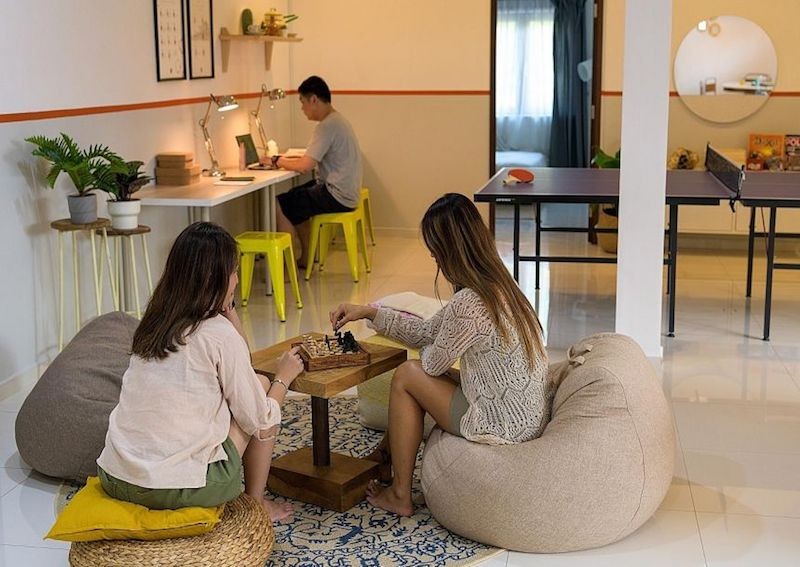Should you choose co-living or renting when moving out of your parents’ house?

If you’re considering moving out of your nest and plunging right into total independence, here’s everything you need to know about co-living versus rental, including the costs.
With working from home (WFH) becoming the new norm, as well as the increased conversations about mental health, moving out of one’s parental home at 21 is also fast becoming the new #adulting standard as more of us now see the importance of having our own space to be productive or just to stay sane.
If you’re not yet financially capable or old enough to get your own place, then renting or co-living are your alternatives. Below, we compare the two options to help you make a decision
What is co-living?
Co-living is a form of communal residence where you’ll be given your own private bedroom along with furnished shared spaces including a bathroom, living room and kitchen – basically a fancier version of living in a university hall.
While different co-living spaces differ, they typically offer housekeeping services, while some even offer meal plans.
You can easily browse through a selection of co-living spaces on sites such as Hmlet, Figment and Commontown, where you can choose your preferred room size – from pocket rooms to full apartments.
Contrary to popular belief, co-living is actually legal in Singapore, and quite a popular option for those on a budget.
Cost breakdown of co-living
| Company | Type of room/apartment | Rental per month |
| Hmlet | Pocket roomRegular roomMaster room | From S$1,200 From S$1,600 From S$2,000 |
| Cove | Standard roomStudio | From S$800From S$2,100 |
| Commontown | Standard roomJunior Master roomMaster room | From S$1,400From S$1,600From S$2,100 |
| Figment | Studio (Shophouse suites) | From S$1,950 |
| Casa Mia | Piccola roomStandard roomMaster room | From S$950From S$1,500From S$2,100 |
| Login Apartment | Common room | From S$1,200 |
| Hei Homes | Pod roomStandard roomMaster room | From S$700From S$1,250From S$1,700 |
| Dash Living | Common roomMaster room | From S$800From S$1,550 |
Pros of co-living
1. Fully furnished rooms
One of the greatest benefits of co-living would be that the rooms are all already furnished for you, so you can expect to enjoy a functional television, microwave, washing machine alongside a strong wifi connection.
If you’re co-living in a condominium, facilities like the pool and gym are also accessible to you.
Aside from the sheer convenience of having a house that is move-in ready, you can also save a great deal of money on these purchases. Different spaces offer different degrees of furnishing and amenities, but will of course come with different price tags as well.
2. Flexibility
Those who are looking for short-term accommodation of a few months will find co-living a much more viable option. Because you are not bound by a lease or a landlord, the duration of stay is very flexible and can be determined by you. Simply put, you can up and leave anytime you want to.
3. Community
Living with a built-in community has probably got to be the cherry on top for some. Although it might be a nightmare for introverts, mingling with housemates in the co-living space will be beneficial for those who enjoy basking in the company of others.
You can form long-lasting relationships and make deep connections with the group of people you’re living with, and probably also save money by whipping up meals together with them. Some co-living spaces even organise activities and events for you and your flatmates to bond.
Cons of co-living
1. Potential conflicts
Though it’s great to have some form of human interaction as opposed to coming home to four blank walls, living with strangers can also invite potential conflicts.
This may happen if one party doesn’t do his fair share of household chores, or if another possesses bad living habits that affect the rest. As tight as you are with your community, there’s bound to be a few disagreements along the way.
2. Fewer locations compared to rental flats
Since there are significantly fewer listings for co-living spaces, location may not be in your favour. With most co-living spaces available in the central or CBD area, you won’t find many in the heartlands or specific neighbourhoods that you prefer.
If you want to live near your parents or where food is affordable and aplenty, choosing to co-live may restrict your choices if you have a specific location in mind aside from the central area.
3. Expensive
Because of the fully furnished Pinterest-worthy rooms that are move-in ready, coupled with housekeeping services and the host of social activities organised for you, co-living can burn quite a hole in your pocket.
So be sure to do the necessary financial planning and set aside enough money so you don’t end up spending way above your means.
| Pros of co-living | Cons of co-living |
| Furnished | Potential conflicts |
| Flexible period of stay | Fewer locations |
| Community | More expensive |
What is renting?
Be it HDB flats, condominiums, service apartments, penthouses or landed property, there is a range of apartment types that you can choose from, depending on your budget and preferred room size.
When it comes to renting, landlords will usually require a stay period of at least three months, though they would favour a tenant with a longer period of stay. The whole process of renting a place includes the signing of a lease, a tenancy agreement and a hefty security deposit to pay upfront.
Unlike co-living, rental properties can be unfurnished, partially-furnished or fully furnished, so it’s best to look out for that.
Cost breakdown of renting
The following prices are for a single room/studio apartment.
| Type of accomodation | Location | Rental per month |
| HDB | HeartlandsCentral/CBD | $450 – $900S$600 – $1,400 |
| Condominium | HeartlandsCentral/CBD | $750 – $2,000S$900 – $2,300 |
| Landed property | HeartlandsCentral/CBD | $800 – $1,900S$1,000 – $2,500 |
Pros of renting
1. More affordable
If you’re on a budget, renting may be the more viable option as it gives you the bare minimum of having a space to come home to every day. If you can do without the housekeeping services and loathe socialising, you’ll definitely save more if you choose to rent.
2. No need to socialise
Sometimes, all we want is a conducive space of our own where we can let our creative juices flow. And that’s what renting a home can give you.
Though renting a room may mean living with your landlord, there won’t be social events and activities that you’ll be peer pressured into joining, unlike at a co-living space. In fact, most tenants and landlords typically go about their day with out conversing with one another.
3. Live anywhere on the island
Another perk of renting a flat would be the freedom of choosing absolutely anywhere you want to stay. Be it near your office once WFH arrangements ceases or living near your family, there’s a myriad of listings available on PropertyGuru or 99.co that offers a wider range of location options.
Because of the sheer number of spaces up for rental, you can choose a home catered specifically to your needs.
A two-bedroom HDB flat that’s north-facing at the heart of Hougang beside your favourite bak chor mee stall that’s fully furnished? Chances are you’ll probably find one that can come close to it.
Cons of renting
1. Long-term
Renting an apartment or a room typically requires a commitment for about a year, though if the space you’re eyeing is a hot choice for many, landlords will most likely prioritise tenants who are in it for the long haul of up to a few years.
This will be a problem for those who are looking for temporary accommodation of several months.
2. You’re responsible for your own home insurance
Because of the prolonged duration of staying at these rental flats, you’ll probably need to get your own home insurance as a tenant. Home insurance will be extremely important for monetary coverage by the company in cases of theft, fire or any damage.
| Pros of renting | Cons of renting |
| No need to socialise | Only for long-term |
| Abundance of locations | Onus of getting home insurance is on you |
| More affordable |
Which should you choose?
| Co-living | Renting | |
| Type available | 1-room/studioHDB, Condominium, Landed property, Penthouse | 1-room/studio, 2-room, 3-room, 4-room, 5-room, Executive Condominium (EC)HDB, Condominium, Landed Property, Penthouse |
| Furnishing | Fully furnished | Fully furnishedPartially furnishedUnfurnished |
| Period of stay | A few months | At least a year |
| Affordability | Cheaper | More expensive |
| Location | Lesser options | More options |
Who is more suitable for co-living?
Though co-living may sound like an attractive option for accommodation, it is not for everyone. It is catered mostly to those who are looking for short-term lodging for a few months.
It is also perfect for extroverts who enjoy meeting new people and forging new connections in a close-knit community, and definitely not for those who value their privacy, peace and quiet. However, be sure to have enough savings set aside as the prices don’t come cheap.
Who is more suitable for renting?
For those looking for a more long-term option, renting can save you a significant amount of money as the monthly rental prices are more affordable. Renting would hence appeal to young adults who don’t necessarily have a big paycheck and are looking to move out from their parents’ home.
However, don’t expect much from rental apartments as they are considered the no-frills counterparts of co-living spaces. There is no housekeeping service and some rooms even come unfurnished so you’ll have to fork out your own money to get the basic necessities.
If you’re not a social butterfly and can do without unnecessary socialising, choosing to rent would be a no-brainer.












Leave a Reply